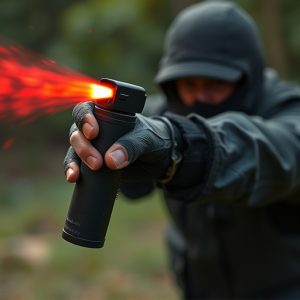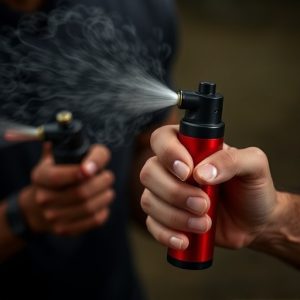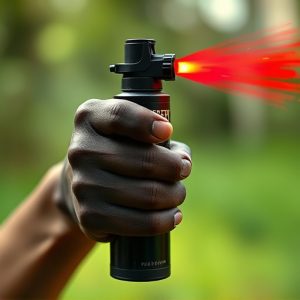Mastering Tactical Pepper Spray: Effectiveness, Safety, and Legalities
Pepper spray, a powerful self-defense tool, harnesses capsaicin to disable attackers temporarily. Po…….
Pepper spray, a powerful self-defense tool, harnesses capsaicin to disable attackers temporarily. Post-use, proper eye washing with 15+ minutes of water flushing is crucial to prevent severe irritation or damage. The choice between tactical (stronger, longer range) and personal use (smaller, easier to carry) pepper spray depends on individual needs and local laws. Following the Pepper Spray Eye Washing Procedure immediately after exposure alleviates symptoms and prevents complications. Best practices for carrying pepper spray include understanding legalities, keeping it accessible, practicing aim, and knowing de-escalation techniques.
“Tactical pepper spray has emerged as a powerful tool for personal protection, offering individuals a means to deter and escape potential threats. This comprehensive guide delves into the world of pepper spray self-defense, exploring its composition, effectiveness, and diverse applications. From understanding key differences between tactical and personal use sprays to choosing the right fit, we demystify this potent defense mechanism. Additionally, we outline crucial steps for the Pepper Spray Eye Washing Procedure, emphasizing safety precautions. By covering legal considerations and best practices for carrying pepper spray, this article equips readers with vital knowledge for proactive self-protection.”
- Understanding Pepper Spray: Its Composition and Effectiveness
- Tactical Pepper Spray vs. Personal Use: Key Differences
- Choosing the Right Pepper Spray for Self-Defense
- Pepper Spray Eye Washing Procedure: Steps and Precautions
- Legal Considerations and Best Practices for Carrying Pepper Spray
Understanding Pepper Spray: Its Composition and Effectiveness
Pepper spray is a powerful tool for self-protection, designed to disrupt an attacker’s vision and breathing capabilities. Its active ingredient is capsaicin, a chemical compound found in chili peppers, which causes irritation and temporary blindness when introduced to the eyes and respiratory system. The spray creates a layer of oleoresin capsicum (OC) oil that coats the skin and mucous membranes, leading to intense pain and discomfort.
When using pepper spray for self-defense, it’s crucial to understand the eye-washing procedure afterward. Since capsaicin can cause severe irritation and potential damage to eyes and lungs, immediate and thorough washing is essential. If contact occurs with eyes or skin, flush them with plenty of water for at least 15 minutes. Seek medical attention if any adverse reactions persist or worsen. Proper training in pepper spray handling and decontamination techniques ensures its effectiveness as a self-defense tool while minimizing risks.
Tactical Pepper Spray vs. Personal Use: Key Differences
Tactical pepper spray is designed for law enforcement and military operations, where its potency and range are crucial. It’s formulated to cause severe irritation, enabling users to incapacitate targets quickly in high-risk scenarios. In contrast, personal use pepper spray is marketed for civilians and focuses more on safety than brute force. While both types contain capsaicin, the active ingredient responsible for the burning sensation, tactical varieties have significantly higher concentrations, making them effective at greater distances.
Moreover, tactical pepper spray often includes features like advanced spraying mechanisms, designed to minimize the risk of eye washing procedure mistakes. Personal use options tend to be smaller and easier to carry, but they may not offer the same level of protection against determined attackers. The choice between tactical and personal use depends on individual needs, with tactical spray suitable for professionals requiring maximum force and control, while personal use spray is ideal for civilians seeking a reliable self-defense option that’s easy to deploy in an emergency.
Choosing the Right Pepper Spray for Self-Defense
Choosing the right pepper spray for self-defense is a crucial step in preparing for potential threats. Consider factors like strength, range, and application method when selecting your weapon. Pepper sprays vary in capsaicin concentration, with higher levels offering more potent protection but also increasing the risk of eye irritation or damage if not used properly. Opting for a spray with a reach of 20-30 feet gives you distance to defuse a dangerous situation.
Familiarize yourself with the pepper spray eye washing procedure in case of accidental exposure or misuse. This includes having access to clean water and understanding how to irrigate the eyes thoroughly. It’s also beneficial to practice aiming techniques and familiarize yourself with local laws regarding self-defense sprays to ensure their legal use and possession.
Pepper Spray Eye Washing Procedure: Steps and Precautions
In the event of accidental or intentional exposure to pepper spray, promptly initiating the Pepper Spray Eye Washing Procedure is crucial for effective decontamination and relief from irritation. Start by immediately flushing the affected eyes with clean, warm water for at least 15 minutes, ensuring thorough rinsing of all eye surfaces, including under eyelids. This initial step helps to dilute and disperse the pepper spray chemicals.
After the initial water flush, use specialized eye wash solutions or clean, sterile irrigation fluid if available. Continue washing for an additional 5-10 minutes while gently massaging the closed eyelids to aid in removing any residual spray. Ensure that no water or solution gets into the nostrils and ears, as this could cause further irritation. Always seek medical attention immediately if eye discomfort persists or severe symptoms develop.
Legal Considerations and Best Practices for Carrying Pepper Spray
Carrying tactical pepper spray for self-protection comes with a range of legal considerations. While many areas permit the use of pepper spray for personal safety, regulations vary significantly from region to region. Before purchasing or carrying pepper spray, individuals should research and understand local laws to avoid any potential legal repercussions. Some jurisdictions have specific restrictions on the type, quantity, and accessibility of pepper spray, while others may mandate a permit or training certificate.
Best practices for carrying pepper spray include ensuring it’s easily accessible but not visible to deter unwanted attention. Many recommend keeping it in a readily available pocket or bag, understanding its reach, and practicing the pepper spray eye washing procedure. It’s crucial to familiarize yourself with the spray’s activation mechanism and range, as well as any de-escalation techniques to avoid unnecessary confrontations. Regular maintenance and checking of expiration dates are also essential for optimal effectiveness and safety.
In conclusion, tactical pepper spray can be an effective tool for self-protection when used appropriately. Understanding its composition, knowing the key differences between tactical and personal use, and choosing the right product are crucial steps. Mastering the Pepper Spray Eye Washing Procedure is essential for minimizing harm and ensuring safety after deployment. Additionally, being aware of legal considerations and best practices for carrying pepper spray will help you maintain compliance while protecting yourself and others.


